You are using an out of date browser. It may not display this or other websites correctly.
You should upgrade or use an alternative browser.
You should upgrade or use an alternative browser.
Brian Hanson passaround
- Thread starter Delat
- Start date

Help Support Kitchen Knife Forums:
This site may earn a commission from merchant affiliate
links, including eBay, Amazon, and others.
I’m assuming the passaround is with @tostadas by now? Any comments on the knife so far @crockerculinary or @xsmx13 ?
List as of March 13:
List as of March 13:
- @crockerculinary NorCal
- @xsmx13 NorCal
- @tostadas NorCal
 @ch_br SoCal (CURRENT TESTER)
@ch_br SoCal (CURRENT TESTER)- @blokey SoCal
- @Malcolm Johnson UT
- @pcs-abc PA
- @brimmergj VT
- @Justinv NY
- @Up_dog128 NC
- @Jville FL
Last edited:
Sorry all, it's been a crazy week and now we're back to disaster activation for potential flooding in Sacramento so I better get to sharing thoughts while I have a moment.
Use: I didn't get to use it as much I would have liked, but it got in the mix to prep some minestrone, a stir fry, and some poké.
Pros:
1. Took and held a nice edge (admittedly I didn't use enough to really gauge retention).
2. I don't use 210's much but I appreciated the extra height.
3. The handle offered a nice piece of burl for the price point.
4. I liked the profile more than I initially expected with the belly being balanced by a good sized flat with a forward slope to the overall shape. The shape reminded me very much of an S. Tanaka Blue 2, but with more taper in the grind and a solid if not overly aggressive distal taper.
5. Nice budget offering of 52100 steel.
Cons (to be fair I'm being a bit overly picky on some of these for a sub $300.00 knife made in the US):
1. The blade had a substantial twist to it towards the front 1/3 of the blade and some waviness to the edge. It was pronounced enough to be visible looking down at the blade while using it. Visibly it bothered me, but did it affect the cutting ability? Not for me. I'd be curious if it felt differently for a righty.
2. There was some slight uneven portion of the grind close to the end in one spot (sorry, I forgot to take a pic and I can't recall exactly where it was) and some finish inconsistencies.
3. No distal taper to the handle. To be fair this is just a pet peeve of mine for any wa handle and the handle was comfortable in use.
4. Narrow neck isn't my favorite, but this just comes down to personal preference.
Conclusion:
To be fair, my cons 2-4, are mostly personal preference pieces and are the compromises to be expected in a more budget line. I ended up testing it three times to compare against a couple of my favorite knives and as a stand alone. The comparisons we're an MCX Spåre 250mm x 56mm Apex Ultra gyuto and a 255mm x 58mm Kamon 1.2519 gyuto. I definitely leaned towards these two in each side by side comparison, but they're some of my most heavily used knives (and yes comparison to $1300.00 and $450.00 knives is a little unfair, but I think Spåre is an interesting comparison I'll get to a little later). In retrospect I wish I had tried something a little more comparable in size and weight but I don't have many 210's.
In performance, the one place where this really lagged behind was where it just didn't feel great cutting the fish. Initially I was surprised because I thought it had a really nice edge on it. In testing I was paying close attention to account for the length difference and it took half the blade length for the largest cuts on the Kamon vs. about 1 1/2 full length draws on the Hanson. The edge felt good, I just think it came down to how thin behind the edge the Kamon is. This one scenario aside it felt good to use. It felt nimble, I appreciated the height on a 210mm knife, and using it as a stand alone it just felt like a nice all around tool that didn't leave me feeling like I need to grab anything different. If I wanted an all around knife in the $250ish range this offers an interesting option, moreso if you place a premium on something made in the US. I think in the bigger picture of custom makers this a tough price point as jumping the $350.00 threshold can offer a big step up in refinement from makers like Spåre, AG Klint, and Birgersson amongst others. If you're deadset one staying under $300.00 or especially like taller 210 range knives, these are worth consideration. I'm curious to see the higher-end line up close for comparison.
Postscript:
Very different knives, but it makes me think of two of my favorite workhorse knives, on one side is a 270mm Xerxes and the other is a collection of 4 Munetoshi gyuto. I don't give a **** about the imperfections in the Munetoshi's, I just enjoy the project in a couple of them, beat on the third one, and tell myself to sell the Migaki so I can buy a 270mm kurouchi. On the Xerxes, it feels effortless and the craftmanship is pretty much flawless, the Munetoshi is just a great knife that I don't feel like I need to baby. I love them both. If you get a good one of these I think it can fall in that Munetoshi camp (albeit at a much lighter weight).
Thank you to @Delat, @Matt Jacobs and @Brian Hanson for the pass around.
Cheers!
Use: I didn't get to use it as much I would have liked, but it got in the mix to prep some minestrone, a stir fry, and some poké.
Pros:
1. Took and held a nice edge (admittedly I didn't use enough to really gauge retention).
2. I don't use 210's much but I appreciated the extra height.
3. The handle offered a nice piece of burl for the price point.
4. I liked the profile more than I initially expected with the belly being balanced by a good sized flat with a forward slope to the overall shape. The shape reminded me very much of an S. Tanaka Blue 2, but with more taper in the grind and a solid if not overly aggressive distal taper.
5. Nice budget offering of 52100 steel.
Cons (to be fair I'm being a bit overly picky on some of these for a sub $300.00 knife made in the US):
1. The blade had a substantial twist to it towards the front 1/3 of the blade and some waviness to the edge. It was pronounced enough to be visible looking down at the blade while using it. Visibly it bothered me, but did it affect the cutting ability? Not for me. I'd be curious if it felt differently for a righty.
2. There was some slight uneven portion of the grind close to the end in one spot (sorry, I forgot to take a pic and I can't recall exactly where it was) and some finish inconsistencies.
3. No distal taper to the handle. To be fair this is just a pet peeve of mine for any wa handle and the handle was comfortable in use.
4. Narrow neck isn't my favorite, but this just comes down to personal preference.
Conclusion:
To be fair, my cons 2-4, are mostly personal preference pieces and are the compromises to be expected in a more budget line. I ended up testing it three times to compare against a couple of my favorite knives and as a stand alone. The comparisons we're an MCX Spåre 250mm x 56mm Apex Ultra gyuto and a 255mm x 58mm Kamon 1.2519 gyuto. I definitely leaned towards these two in each side by side comparison, but they're some of my most heavily used knives (and yes comparison to $1300.00 and $450.00 knives is a little unfair, but I think Spåre is an interesting comparison I'll get to a little later). In retrospect I wish I had tried something a little more comparable in size and weight but I don't have many 210's.
In performance, the one place where this really lagged behind was where it just didn't feel great cutting the fish. Initially I was surprised because I thought it had a really nice edge on it. In testing I was paying close attention to account for the length difference and it took half the blade length for the largest cuts on the Kamon vs. about 1 1/2 full length draws on the Hanson. The edge felt good, I just think it came down to how thin behind the edge the Kamon is. This one scenario aside it felt good to use. It felt nimble, I appreciated the height on a 210mm knife, and using it as a stand alone it just felt like a nice all around tool that didn't leave me feeling like I need to grab anything different. If I wanted an all around knife in the $250ish range this offers an interesting option, moreso if you place a premium on something made in the US. I think in the bigger picture of custom makers this a tough price point as jumping the $350.00 threshold can offer a big step up in refinement from makers like Spåre, AG Klint, and Birgersson amongst others. If you're deadset one staying under $300.00 or especially like taller 210 range knives, these are worth consideration. I'm curious to see the higher-end line up close for comparison.
Postscript:
Very different knives, but it makes me think of two of my favorite workhorse knives, on one side is a 270mm Xerxes and the other is a collection of 4 Munetoshi gyuto. I don't give a **** about the imperfections in the Munetoshi's, I just enjoy the project in a couple of them, beat on the third one, and tell myself to sell the Migaki so I can buy a 270mm kurouchi. On the Xerxes, it feels effortless and the craftmanship is pretty much flawless, the Munetoshi is just a great knife that I don't feel like I need to baby. I love them both. If you get a good one of these I think it can fall in that Munetoshi camp (albeit at a much lighter weight).
Thank you to @Delat, @Matt Jacobs and @Brian Hanson for the pass around.
Cheers!
Sorry all, it's been a crazy week and now we're back to disaster activation for potential flooding in Sacramento so I better get to sharing thoughts while I have a moment.
Use: I didn't get to use it as much I would have liked, but it got in the mix to prep some minestrone, a stir fry, and some poké.
Pros:
1. Took and held a nice edge (admittedly I didn't use enough to really gauge retention).
2. I don't use 210's much but I appreciated the extra height.
3. The handle offered a nice piece of burl for the price point.
4. I liked the profile more than I initially expected with the belly being balanced by a good sized flat with a forward slope to the overall shape. The shape reminded me very much of an S. Tanaka Blue 2, but with more taper in the grind and a solid if not overly aggressive distal taper.
5. Nice budget offering of 52100 steel.
Cons (to be fair I'm being a bit overly picky on some of these for a sub $300.00 knife made in the US):
1. The blade had a substantial twist to it towards the front 1/3 of the blade and some waviness to the edge. It was pronounced enough to be visible looking down at the blade while using it. Visibly it bothered me, but did it affect the cutting ability? Not for me. I'd be curious if it felt differently for a righty.
2. There was some slight uneven portion of the grind close to the end in one spot (sorry, I forgot to take a pic and I can't recall exactly where it was) and some finish inconsistencies.
3. No distal taper to the handle. To be fair this is just a pet peeve of mine for any wa handle and the handle was comfortable in use.
4. Narrow neck isn't my favorite, but this just comes down to personal preference.
Conclusion:
To be fair, my cons 2-4, are mostly personal preference pieces and are the compromises to be expected in a more budget line. I ended up testing it three times to compare against a couple of my favorite knives and as a stand alone. The comparisons we're an MCX Spåre 250mm x 56mm Apex Ultra gyuto and a 255mm x 58mm Kamon 1.2519 gyuto. I definitely leaned towards these two in each side by side comparison, but they're some of my most heavily used knives (and yes comparison to $1300.00 and $450.00 knives is a little unfair, but I think Spåre is an interesting comparison I'll get to a little later). In retrospect I wish I had tried something a little more comparable in size and weight but I don't have many 210's.
In performance, the one place where this really lagged behind was where it just didn't feel great cutting the fish. Initially I was surprised because I thought it had a really nice edge on it. In testing I was paying close attention to account for the length difference and it took half the blade length for the largest cuts on the Kamon vs. about 1 1/2 full length draws on the Hanson. The edge felt good, I just think it came down to how thin behind the edge the Kamon is. This one scenario aside it felt good to use. It felt nimble, I appreciated the height on a 210mm knife, and using it as a stand alone it just felt like a nice all around tool that didn't leave me feeling like I need to grab anything different. If I wanted an all around knife in the $250ish range this offers an interesting option, moreso if you place a premium on something made in the US. I think in the bigger picture of custom makers this a tough price point as jumping the $350.00 threshold can offer a big step up in refinement from makers like Spåre, AG Klint, and Birgersson amongst others. If you're deadset one staying under $300.00 or especially like taller 210 range knives, these are worth consideration. I'm curious to see the higher-end line up close for comparison.
Postscript:
Very different knives, but it makes me think of two of my favorite workhorse knives, on one side is a 270mm Xerxes and the other is a collection of 4 Munetoshi gyuto. I don't give a **** about the imperfections in the Munetoshi's, I just enjoy the project in a couple of them, beat on the third one, and tell myself to sell the Migaki so I can buy a 270mm kurouchi. On the Xerxes, it feels effortless and the craftmanship is pretty much flawless, the Munetoshi is just a great knife that I don't feel like I need to baby. I love them both. If you get a good one of these I think it can fall in that Munetoshi camp (albeit at a much lighter weight).
Thank you to @Delat, @Matt Jacobs and @Brian Hanson for the pass around.
Cheers!
Thanks for the detailed report. I’m surprised to hear about the twist; I’ll reach out to Brian and see if he wants to get the knife back for an inspection.
Ive got a 180mm petty from him! Its a little on the thick workhorsey side but it takes an excellent edge. (He also makes a sweet bench scraper too)I’ve been eyeing a 180mm petty on his website for a while, people’s comments on this thread are making it hard to make excuse for not buying it now
tostadas
Hobbyist / Craftsman
Brian Hanson
New Member
I hope this is not out of line for me to address the twist found on this forum.
Embarrassed this was overlooked. I would always repair or replace any knife a customer has concerns over.
Embarrassed this was overlooked. I would always repair or replace any knife a customer has concerns over.
tostadas
Hobbyist / Craftsman
Preface
First off, I want to give a very big thanks to Brian Hanson and the organizers for putting this together, and allowing me the opportunity to try out this knife.
In this review, I will try my best to provide as much objective information as possible, but will also give my own unfiltered opinions on features that I like and dislike. I’ll attempt to not make this sound like a sales pitch or a rant. Without further ado, let’s get right into this.
Presentation
The knife arrived nicely packaged in a premium box, one of the nicest I’ve seen. The magnetic closure is a cool touch.
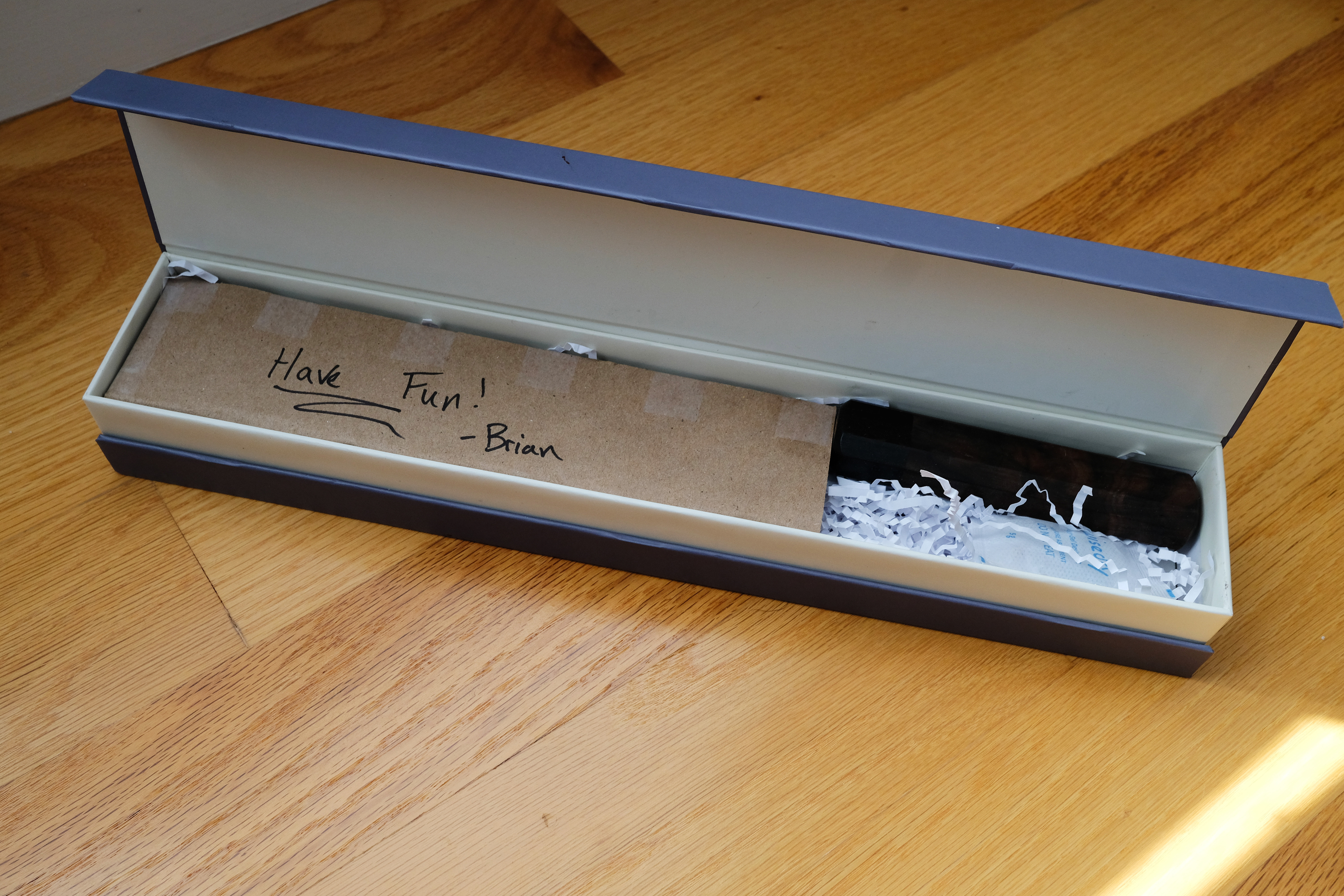
Specs
215 x 53mm, 157g
52100 mono steel, walnut/African blackwood handle
Spine Thickness
Handle: 3.1mm
Heel: 3.1mm
Mid: 1.8mm
1cm from Tip: 0.9mm
Balance: 25mm in front of choil
Thickness Behind Edge at Midpoint
1mm: 0.2mm
5mm: 0.6mm
10mm: 0.9mm
20mm: 1.5mm
Blade Overview
The blade shape resembles a Shiro Kamo with the higher than average heel, and skinny neck. And the profile is a general-purpose one with some flat toward the back, and a gentle curve toward the front (a little more on an issue with the actual profile itself later on); the tip is not particularly upswept or low.
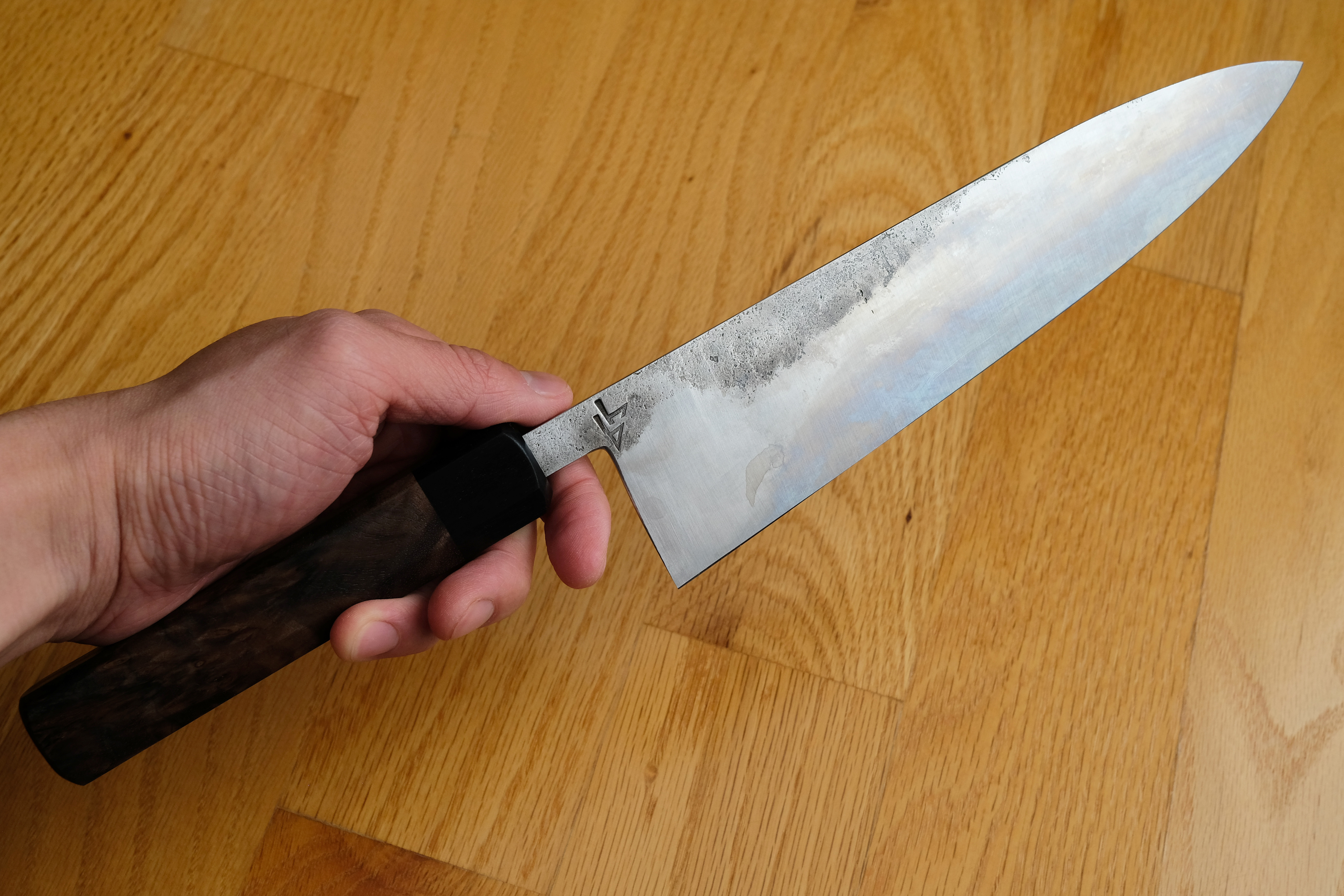
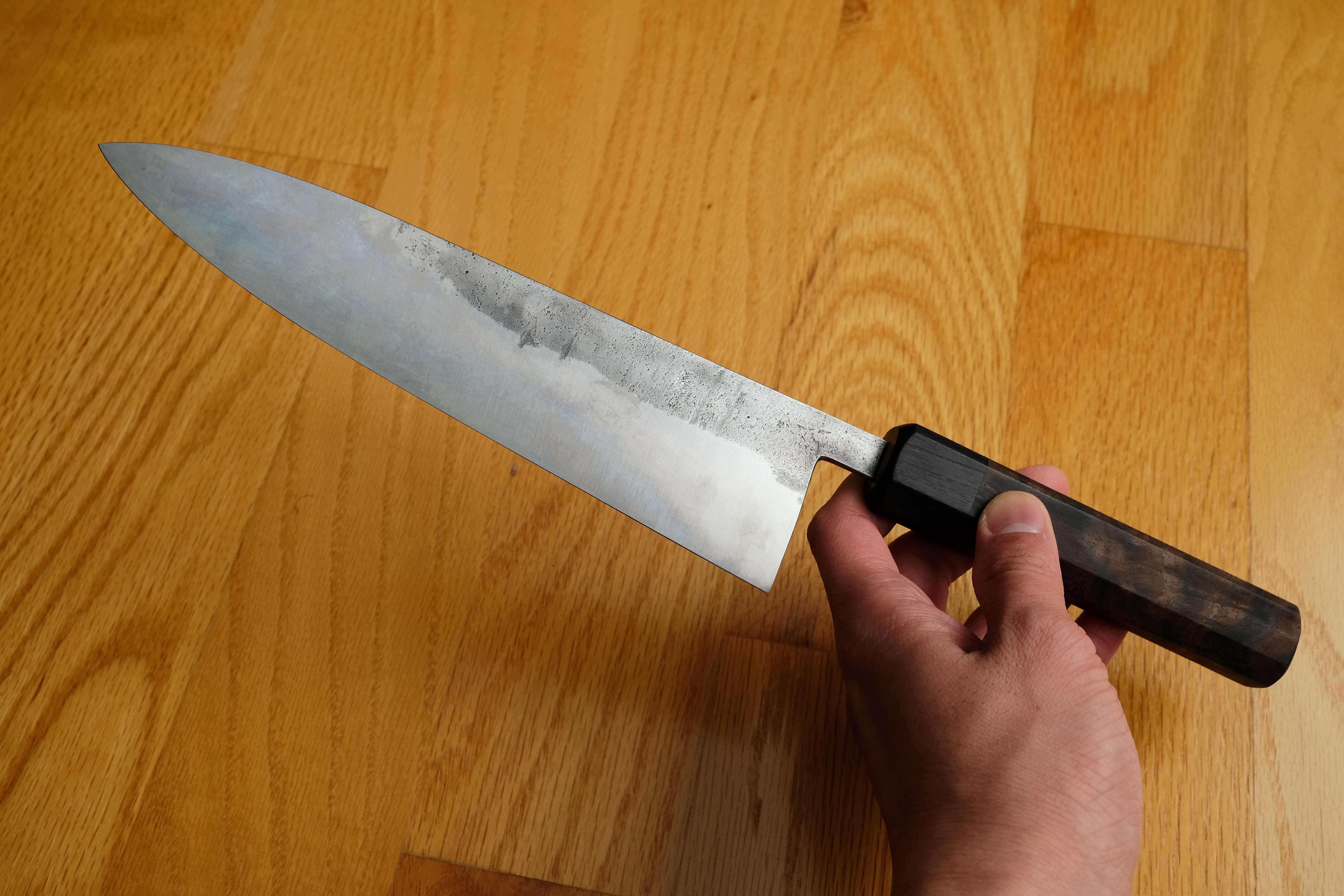
The knife has a slight spine taper from heel to tip.
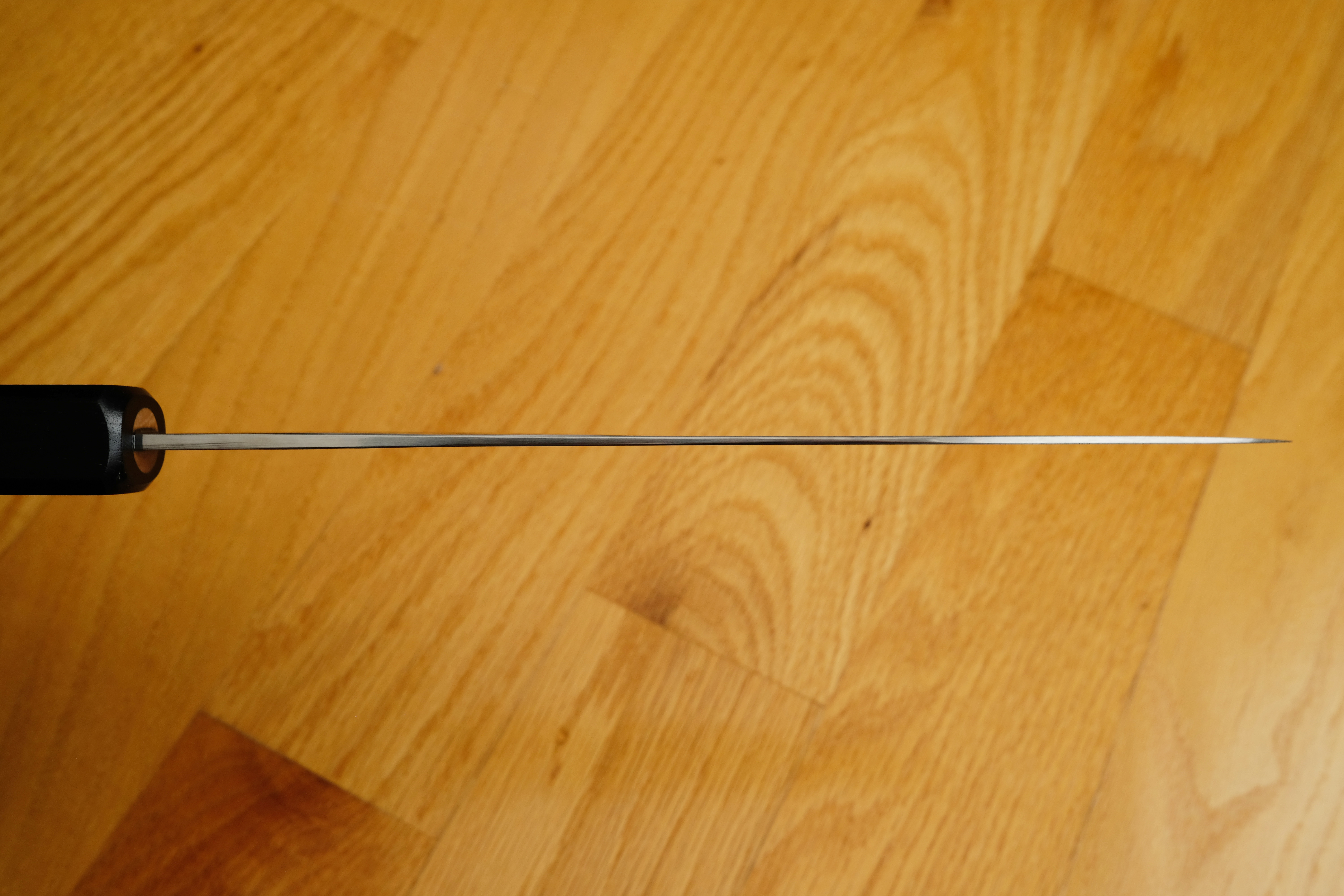
The grind is on the laser side, slight convex on both sides all the way down the blade, flattening toward the tip. Comparing with my database of about 100ish knives I’ve tried, it’s most similar to Takamura R2 in terms of thickness and convexity, however with a beefier spine toward the handle.
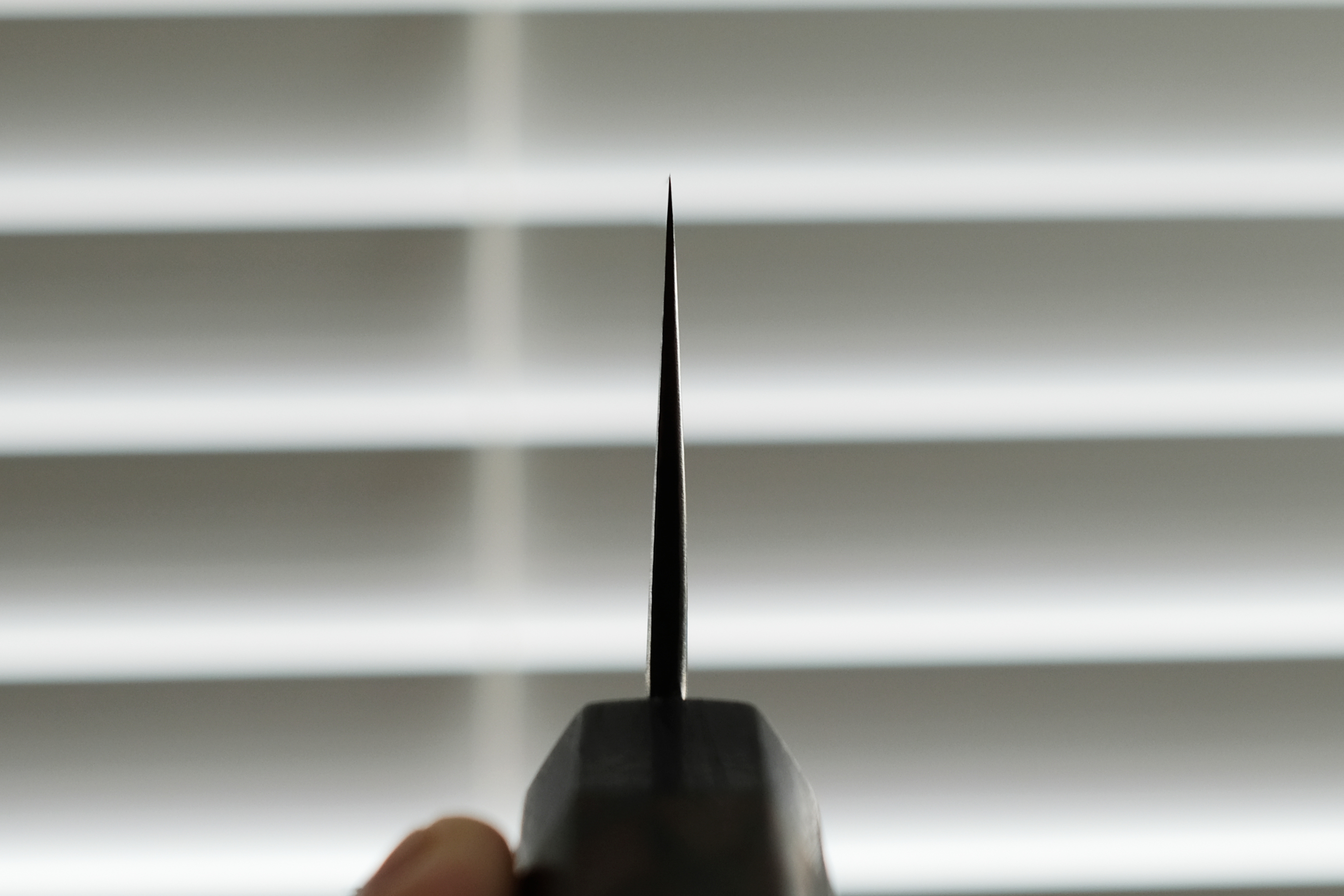
Blade Finish
The grind is a vertical belt finish with some nashiji near the spine. It’s simple and looks nice. Spine and choil are pretty square. Not sharp enough to cut you, but you can definitely feel the edges when gripping the knife.
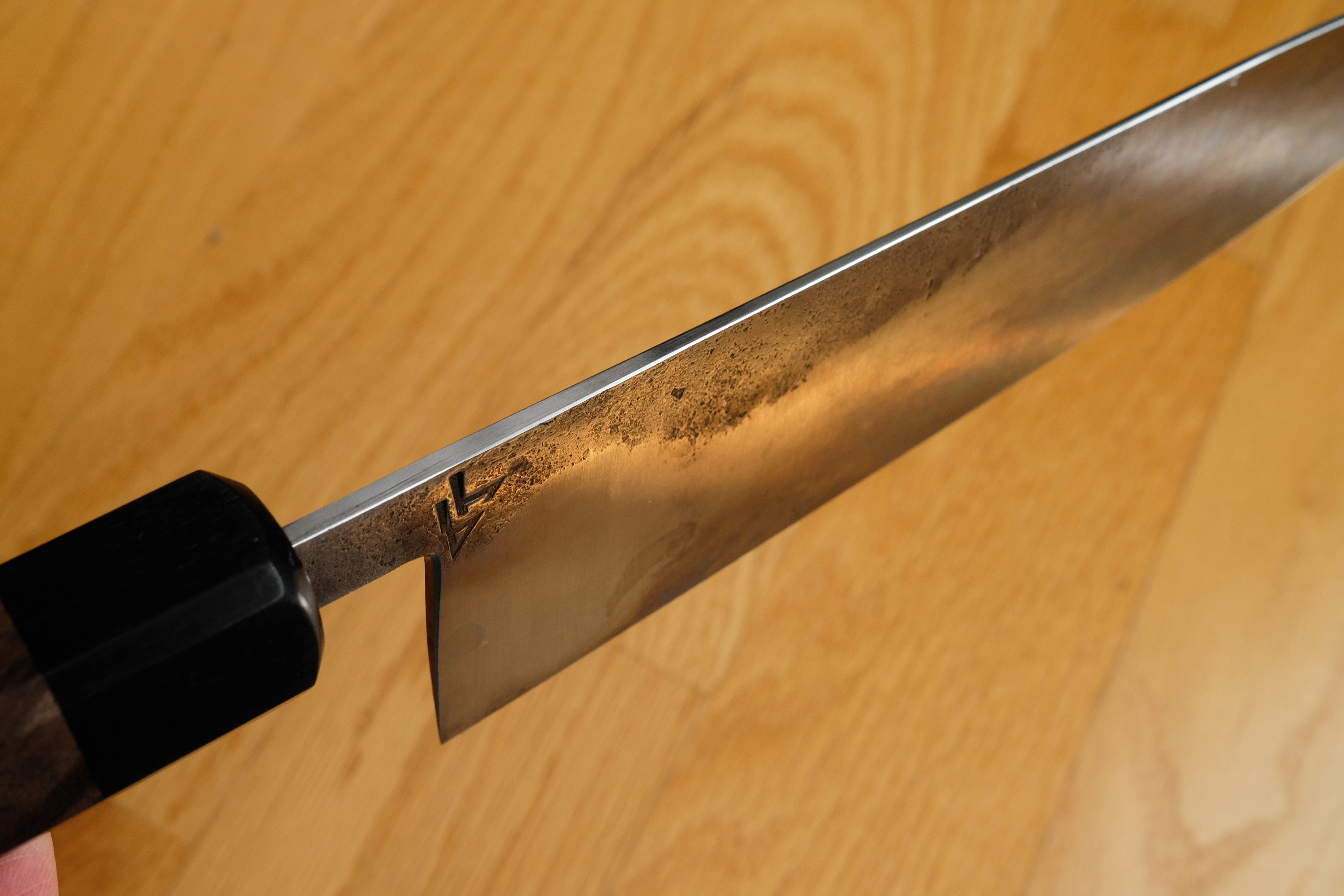
Handle
The handle is walnut and African blackwood, with a wooden dowel construction that is exposed at the front. These are materials I like very much. The transitions between all materials are smooth and the blade installation is straight and clean.
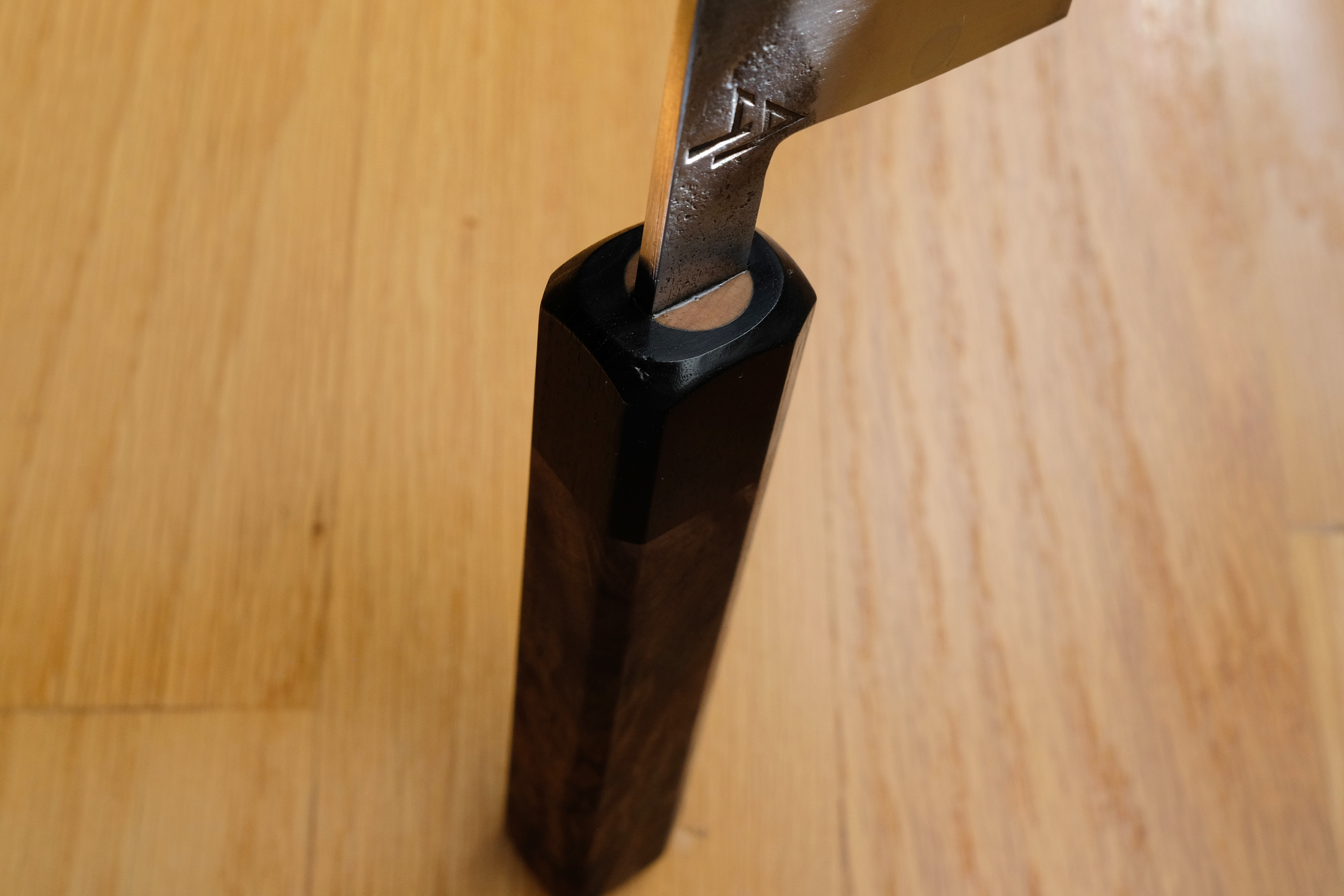
Edges on the front and back are rounded. The handle is approximately 20x25mm (width x height) with very very slight tapering from front to back, so the back is a little bit smaller than the front.
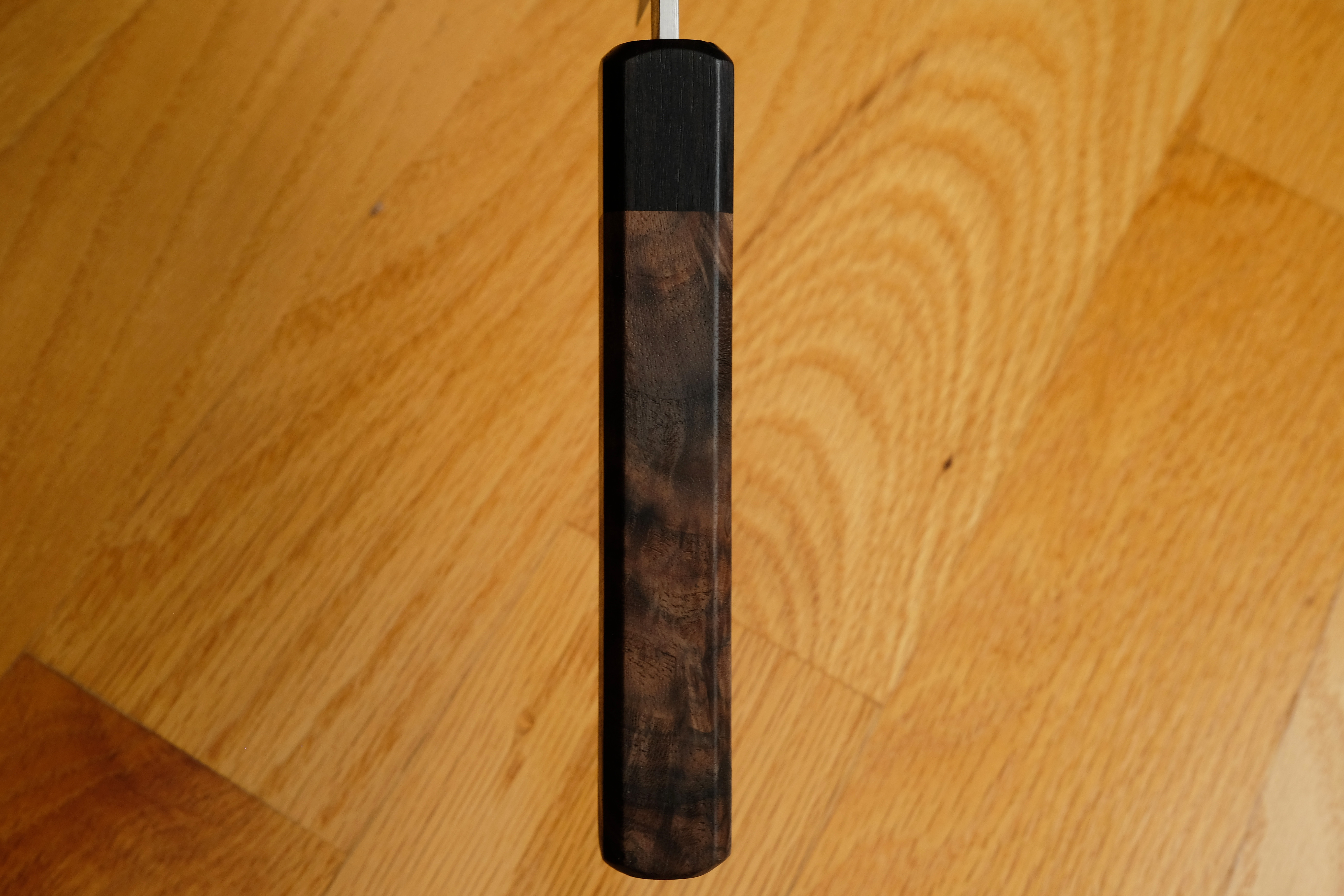
Shape is octagon, but with larger facets on the bottom side, and smaller facets on the top. This handle just did not fit my hand comfortably (I wear about size M/L glove). The front dimensions were a bit too big, especially with the very wide top, and the handle being slightly smaller in the back than in front felt backwards to me. The bottom facets have a steep angle, which when combined with the smooth finish of the wood give me a hard time securing a solid grip along the body of the handle.
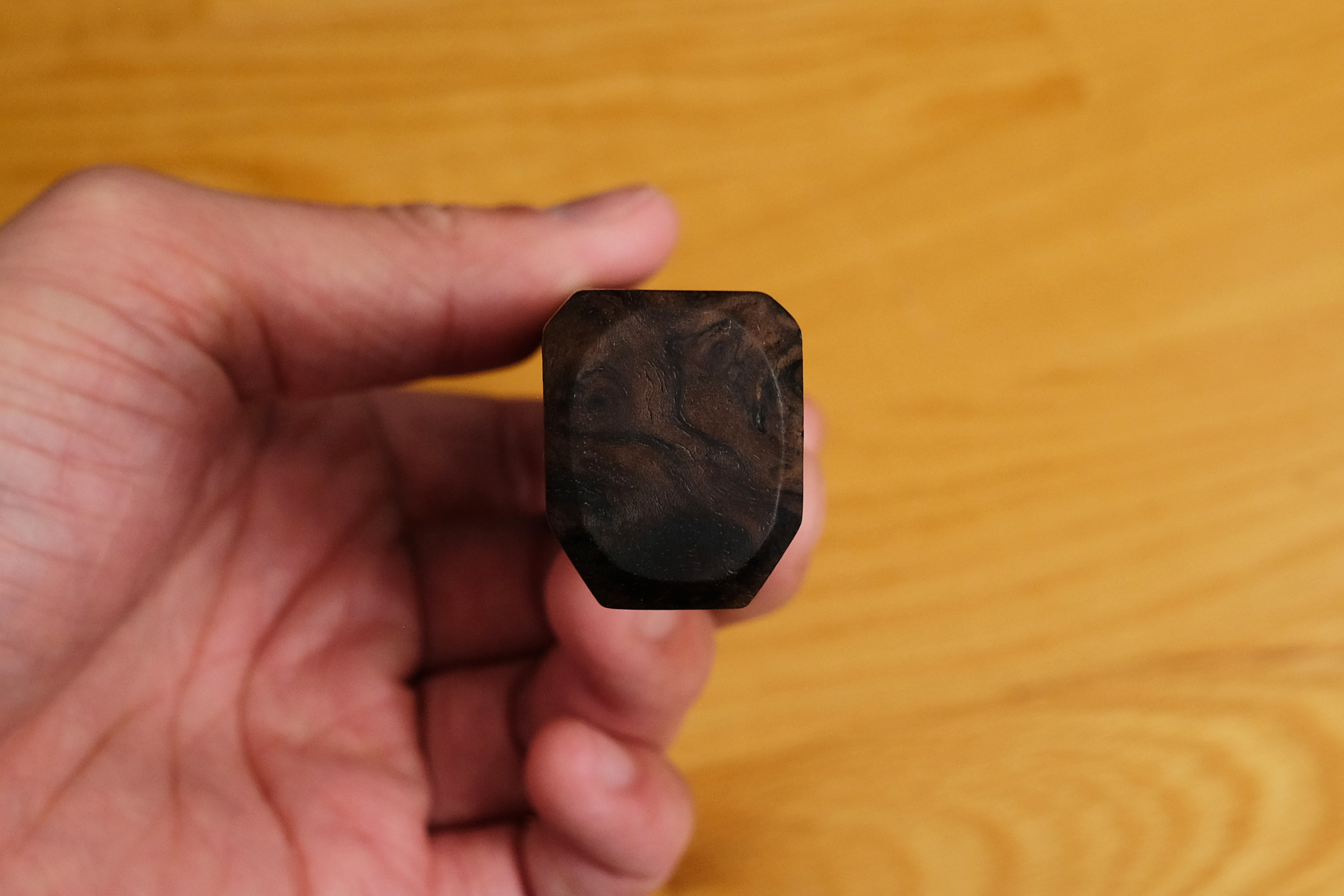
First off, I want to give a very big thanks to Brian Hanson and the organizers for putting this together, and allowing me the opportunity to try out this knife.
In this review, I will try my best to provide as much objective information as possible, but will also give my own unfiltered opinions on features that I like and dislike. I’ll attempt to not make this sound like a sales pitch or a rant. Without further ado, let’s get right into this.
Presentation
The knife arrived nicely packaged in a premium box, one of the nicest I’ve seen. The magnetic closure is a cool touch.

Specs
215 x 53mm, 157g
52100 mono steel, walnut/African blackwood handle
Spine Thickness
Handle: 3.1mm
Heel: 3.1mm
Mid: 1.8mm
1cm from Tip: 0.9mm
Balance: 25mm in front of choil
Thickness Behind Edge at Midpoint
1mm: 0.2mm
5mm: 0.6mm
10mm: 0.9mm
20mm: 1.5mm
Blade Overview
The blade shape resembles a Shiro Kamo with the higher than average heel, and skinny neck. And the profile is a general-purpose one with some flat toward the back, and a gentle curve toward the front (a little more on an issue with the actual profile itself later on); the tip is not particularly upswept or low.


The knife has a slight spine taper from heel to tip.

The grind is on the laser side, slight convex on both sides all the way down the blade, flattening toward the tip. Comparing with my database of about 100ish knives I’ve tried, it’s most similar to Takamura R2 in terms of thickness and convexity, however with a beefier spine toward the handle.

Blade Finish
The grind is a vertical belt finish with some nashiji near the spine. It’s simple and looks nice. Spine and choil are pretty square. Not sharp enough to cut you, but you can definitely feel the edges when gripping the knife.

Handle
The handle is walnut and African blackwood, with a wooden dowel construction that is exposed at the front. These are materials I like very much. The transitions between all materials are smooth and the blade installation is straight and clean.

Edges on the front and back are rounded. The handle is approximately 20x25mm (width x height) with very very slight tapering from front to back, so the back is a little bit smaller than the front.

Shape is octagon, but with larger facets on the bottom side, and smaller facets on the top. This handle just did not fit my hand comfortably (I wear about size M/L glove). The front dimensions were a bit too big, especially with the very wide top, and the handle being slightly smaller in the back than in front felt backwards to me. The bottom facets have a steep angle, which when combined with the smooth finish of the wood give me a hard time securing a solid grip along the body of the handle.

Last edited:
tostadas
Hobbyist / Craftsman
Blade Defects
The blade did not appear damaged in any way when I received it, but there were two issues I noticed during inspection.
The edge is angled to one side toward the front part of the knife. If holding the knife in a cutting position, the edge kinda goes to the right. However, the spine looks straight, so you can think of it as a bit of a “twist.” I don’t think it had any noticeable effect on performance, but still something worth noting.
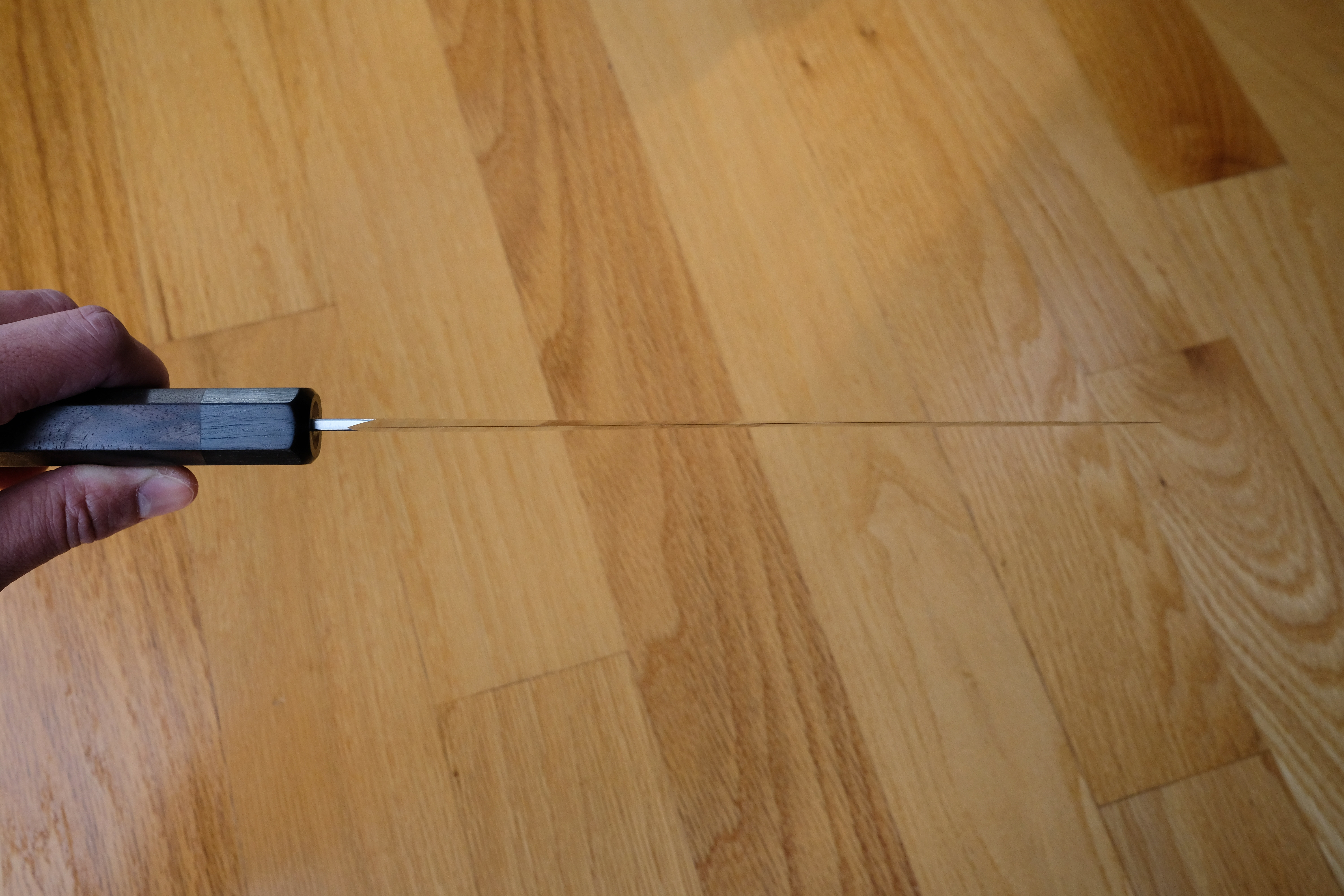
The profile also has short section of recurve or “hole” toward the back. This is definitely noticeable in use, where it creates a sort of stop in the cutting motion. Also it’s noticeable when sharpening the blade.
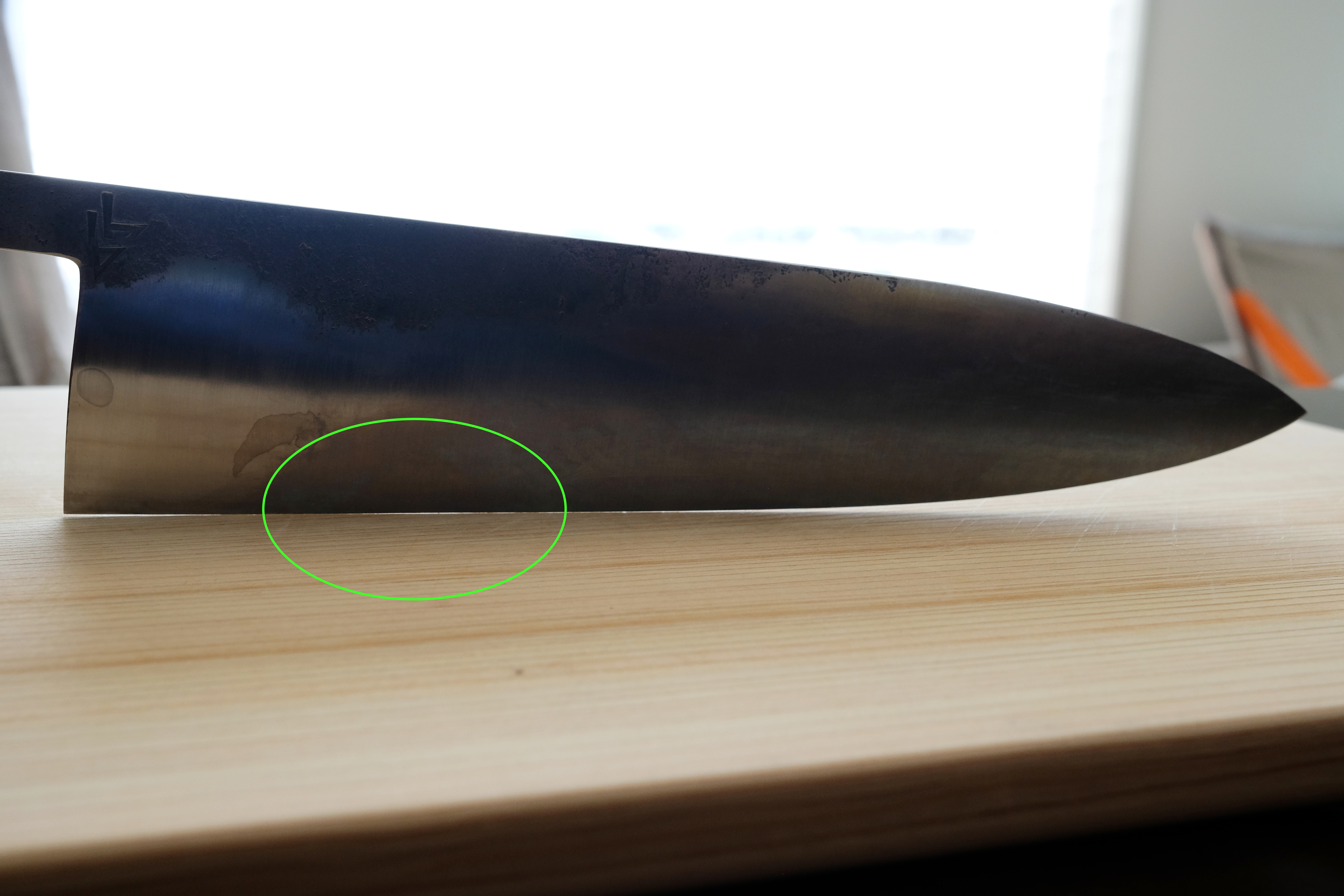
Performance/ Actual Use
I went through a mix of about 20lbs of stuff with the knife, making a big pot of pasta sauce and another big pot of soup. A variety of hard, soft, wet, dry, tall, dense, fatty and some acidic ingredients.
In general, the knife performs like a thin laser (again very similar to the Takamura, which aligns with what I expected from the measurements). Pretty nimble due to its length and weight. It falls through foods, no wedging, no cracking of carrots, goes through onions both vertically and horizontally with little effort. In stuff where I needed a bit more force such as fatty pork shoulder where the edge kinda gets stuck, the square edges on the spine became noticeable, creating pressure point on my grip. I personally was not a fan of the handle design for my hand. As I mentioned earlier in the review, it was difficult to get a solid grip due to the size/shape, so I ended up taking a few breaks during the prep to stretch out my hand some.

I think perhaps the knife’s greatest shortcoming is the stiction. Wet product was getting glued to the blade. I suspect that this is related to the finish of the blade rather than geometry, because I pulled out a couple knives with similar grinds/thickness to test side by side and didn’t notice the same level of sticking.
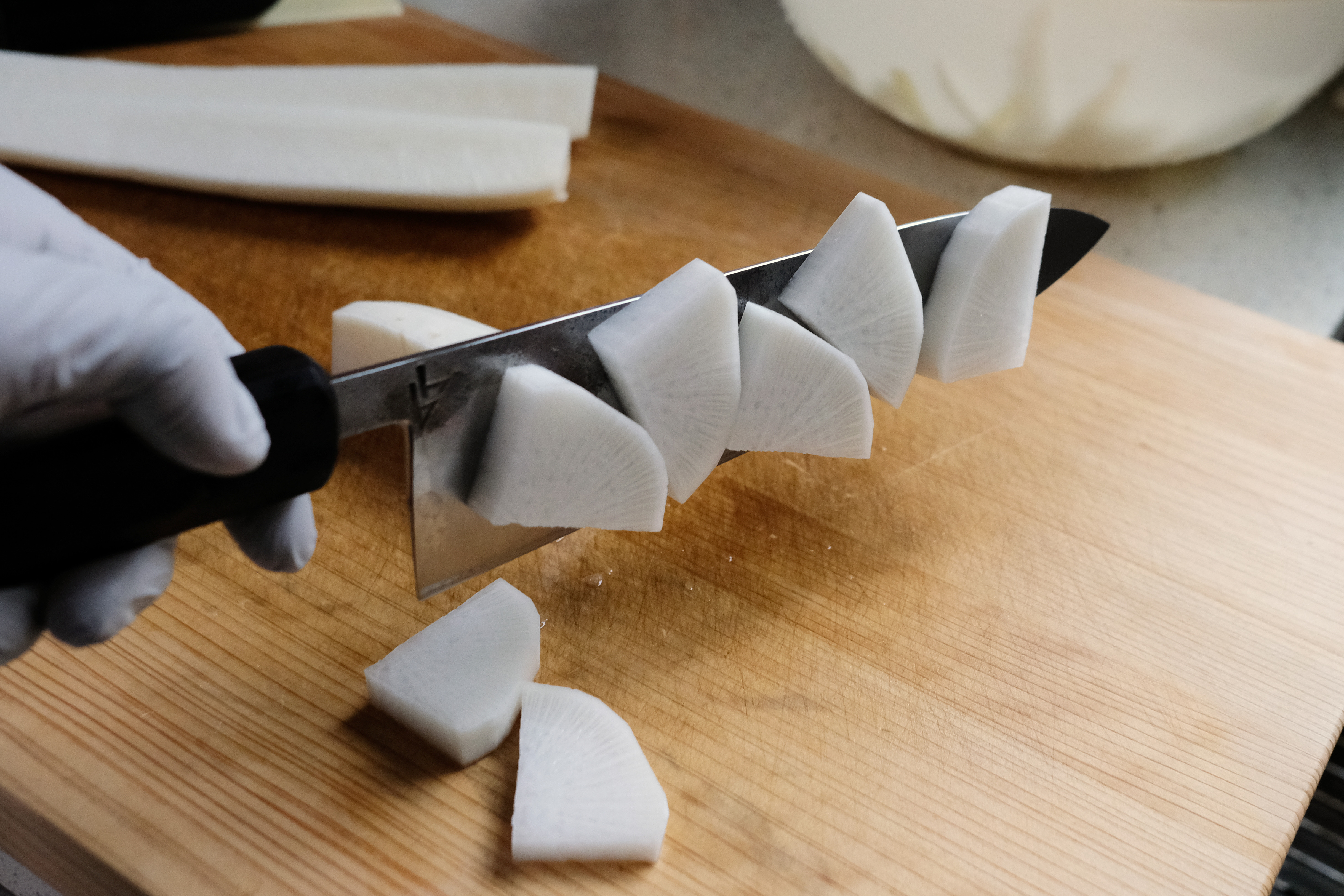
The 52100 steel performed as you would expect. It maintains its edge well, and seems to have minimal reactivity. Onions didn’t blacken, and I didn’t notice any smells that are common when using carbon knives and working with acidic ingredients.
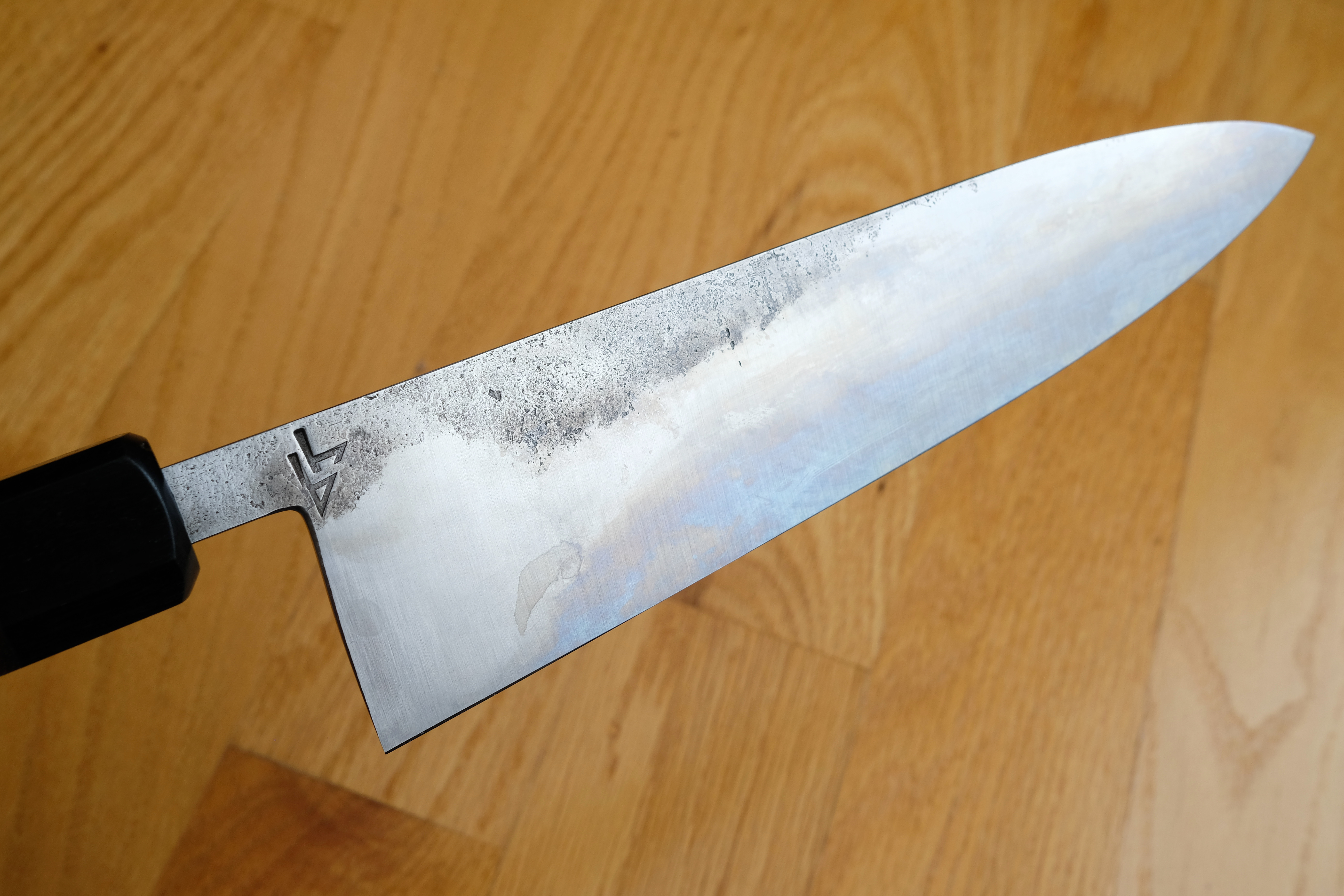
Final Thoughts/ Summary
I have mixed feelings about this knife. I would categorize it with the lasers due to grind and performance, though it has a thicker spine than your typical Takamura or Kono HD2. I understand this is supposed to be a budget version, so it won’t have all the bells and whistles of the higher end, but when considering this knife against other 210mm in the $200-$325 range, there is stiff competition (Ashi Ginga, Kono HD2, Takamura, Shiro Kamo, Wakui, Yoshikane, Matsubara, Manaka, yoake, Shibata, and on the western end, Markin, Spare, etc).
Pros:
Thanks for reading. Again, I really appreciate the opportunity to test drive this knife and share my thoughts with everyone.
The blade did not appear damaged in any way when I received it, but there were two issues I noticed during inspection.
The edge is angled to one side toward the front part of the knife. If holding the knife in a cutting position, the edge kinda goes to the right. However, the spine looks straight, so you can think of it as a bit of a “twist.” I don’t think it had any noticeable effect on performance, but still something worth noting.

The profile also has short section of recurve or “hole” toward the back. This is definitely noticeable in use, where it creates a sort of stop in the cutting motion. Also it’s noticeable when sharpening the blade.

Performance/ Actual Use
I went through a mix of about 20lbs of stuff with the knife, making a big pot of pasta sauce and another big pot of soup. A variety of hard, soft, wet, dry, tall, dense, fatty and some acidic ingredients.
In general, the knife performs like a thin laser (again very similar to the Takamura, which aligns with what I expected from the measurements). Pretty nimble due to its length and weight. It falls through foods, no wedging, no cracking of carrots, goes through onions both vertically and horizontally with little effort. In stuff where I needed a bit more force such as fatty pork shoulder where the edge kinda gets stuck, the square edges on the spine became noticeable, creating pressure point on my grip. I personally was not a fan of the handle design for my hand. As I mentioned earlier in the review, it was difficult to get a solid grip due to the size/shape, so I ended up taking a few breaks during the prep to stretch out my hand some.

I think perhaps the knife’s greatest shortcoming is the stiction. Wet product was getting glued to the blade. I suspect that this is related to the finish of the blade rather than geometry, because I pulled out a couple knives with similar grinds/thickness to test side by side and didn’t notice the same level of sticking.

The 52100 steel performed as you would expect. It maintains its edge well, and seems to have minimal reactivity. Onions didn’t blacken, and I didn’t notice any smells that are common when using carbon knives and working with acidic ingredients.

Final Thoughts/ Summary
I have mixed feelings about this knife. I would categorize it with the lasers due to grind and performance, though it has a thicker spine than your typical Takamura or Kono HD2. I understand this is supposed to be a budget version, so it won’t have all the bells and whistles of the higher end, but when considering this knife against other 210mm in the $200-$325 range, there is stiff competition (Ashi Ginga, Kono HD2, Takamura, Shiro Kamo, Wakui, Yoshikane, Matsubara, Manaka, yoake, Shibata, and on the western end, Markin, Spare, etc).
Pros:
- Top notch presentation
- Laser performance
- Nimble, good balance
- Quality materials
- Low reactivity
- Handle shape not to my preference
- Square spine/choil edges
- Some manufacturing defects in blade
- Stiction in wet product
Thanks for reading. Again, I really appreciate the opportunity to test drive this knife and share my thoughts with everyone.
Last edited:
Blade Defects
The blade did not appear damaged in any way when I received it, but there were two issues I noticed during inspection.
The edge is angled to one side toward the front part of the knife. If holding the knife in a cutting position, the edge kinda goes to the right. However, the spine looks straight, so you can think of it as a bit of a “twist.” I don’t think it had any noticeable effect on performance, but still something worth noting.

The profile also has short section of recurve or “hole” toward the back. This is definitely noticeable in use, where it creates a sort of stop in the cutting motion. Also it’s noticeable when sharpening the blade.

Performance/ Actual Use
I went through a mix of about 20lbs of stuff with the knife, making a big pot of pasta sauce and another big pot of soup. A variety of hard, soft, wet, dry, tall, dense, fatty and some acidic ingredients.
In general, the knife performs like a thin laser (again very similar to the Takamura, which aligns with what I expected from the measurements). Pretty nimble due to its length and weight. It falls through foods, no wedging, no cracking of carrots, goes through onions both vertically and horizontally with little effort. In stuff where I needed a bit more force such as fatty pork shoulder where the edge kinda gets stuck, the square edges on the spine became noticeable, creating pressure point on my grip. I personally was not a fan of the handle design for my hand. As I mentioned earlier in the review, it was difficult to get a solid grip due to the size/shape, so I ended up taking a few breaks during the prep to stretch out my hand some.

I think perhaps the knife’s greatest shortcoming is the stiction. Wet product was getting glued to the blade. I suspect that this is related to the finish of the blade rather than geometry, because I pulled out a couple knives with similar grinds/thickness to test side by side and didn’t notice the same level of sticking.

The 52100 steel performed as you would expect. It maintains its edge well, and seems to have minimal reactivity. Onions didn’t blacken, and I didn’t notice any smells that are common when using carbon knives and working with acidic ingredients.

Final Thoughts/ Summary
I have mixed feelings about this knife. I would categorize it with the lasers due to grind and performance, though it has a thicker spine than your typical Takamura or Kono HD2. I understand this is supposed to be a budget version, so it won’t have all the bells and whistles of the higher end, but when considering this knife against other 210mm in the $200-$325 range, there is stiff competition (Ashi Ginga, Kono HD2, Takamura, Shiro Kamo, Wakui, Yoshikane, Matsubara, Manaka, yoake, Shibata, and on the western end, Markin, Spare, etc).
Pros:
Cons:
- Top notch presentation
- Laser performance
- Nimble, good balance
- Quality materials
- Low reactivity
- Handle shape not to my preference
- Square spine/choil edges
- Some manufacturing defects in blade
- Stiction in wet product
Thanks for reading. Again, I really appreciate the opportunity to test drive this knife and share my thoughts with everyone.
Love the detailed review, thanks!
My example is a lightly customized version of the standard line in the passaround - basically a bit thinner grind and upgraded handle. This is the same handle shape Brian uses on his higher end line and customs which would address the issue you noted. You can see the handle tapers towards the front, and is slimmer on the top vs the sides. I forget how much those two customizations ran, but I think in the neighborhood of $50 (I provided the wood block for the handle, though).
I also had some stiction OOTB although my finish was different (etched). Micro mesh 3000 grit helped a lot, and dropping to 2000 helped even further. I’ve been debating going lower but not sure I want the scratches from a lower grit. I rounded the spine too (you can see a bit in the 2nd photo).


Last edited:
Brian Hanson Passaround Status:
- @crockerculinary NorCal
- @xsmx13 NorCal
- @tostadas NorCal
- @ch_br SoCal
 @blokey SoCal (Current Tester)
@blokey SoCal (Current Tester)- @Malcolm Johnson UT
- @pcs-abc PA
- @brimmergj VT
- @Justinv NY
- @Up_dog128 NC
- @Jville FL
Last edited:
BH Passaround Review:
The blade is presented well in a quality box. It arrived packed very carefully by @tostadas .
I REALLY love the aesthetic of the African blackwood used for handle material.
The insertion point of the blade into the handle was very nicely centered and the epoxy was clean and tidy. I loved seeing this, its something seemingly simple, but isn't generally executed this well.
The feel of the blade is very light and nimble in the hand. Due to its size and weight this essentially feels like a long petty.
Upon inspecting the blade from many angles, I noticed quite a thin spot looking downward on spine--about half way toward the tip.

Caliper measurements confirmed the thinnest spot in the green square above is 1.91mm. The spine then goes back up to 2.31mm thickness before the blade continues a distal taper toward the tip.

During inspection I also found one single 'stain', that might be a hard water spot, toward the heel on the Maker's Mark Side.
I consulted Tostada's before pics and noticed it was there also:

In terms of performance testing, I went through a few waves of tests, making 3 meals. Overall about 8lbs of potatoes, 3 onions, and 1lb of carrots.
It cut potatoes and onions well with no issues at all. The tip was nimble enough to finely mince garlic with no issues.
However, for carrots it took a bit more effort than both the Yoake and Wakui I directly compared it to. While the Wakui is 240mm, both J blades are within the same targeted price point as the Hanson.

And, as previously mentioned, the BH had a high level of stiction to all 3 ingredients pictured above.
Overall the blade performed pretty well. And was fun and easy to wield due to its light feel.
Thanks again to @Delat for the opportunity to test a BH--a blade I had seen a ton of on SM (social media) but had never previously experienced.
The blade is presented well in a quality box. It arrived packed very carefully by @tostadas .
I REALLY love the aesthetic of the African blackwood used for handle material.
The insertion point of the blade into the handle was very nicely centered and the epoxy was clean and tidy. I loved seeing this, its something seemingly simple, but isn't generally executed this well.
The feel of the blade is very light and nimble in the hand. Due to its size and weight this essentially feels like a long petty.
Upon inspecting the blade from many angles, I noticed quite a thin spot looking downward on spine--about half way toward the tip.

Caliper measurements confirmed the thinnest spot in the green square above is 1.91mm. The spine then goes back up to 2.31mm thickness before the blade continues a distal taper toward the tip.

During inspection I also found one single 'stain', that might be a hard water spot, toward the heel on the Maker's Mark Side.
I consulted Tostada's before pics and noticed it was there also:

In terms of performance testing, I went through a few waves of tests, making 3 meals. Overall about 8lbs of potatoes, 3 onions, and 1lb of carrots.
It cut potatoes and onions well with no issues at all. The tip was nimble enough to finely mince garlic with no issues.
However, for carrots it took a bit more effort than both the Yoake and Wakui I directly compared it to. While the Wakui is 240mm, both J blades are within the same targeted price point as the Hanson.

And, as previously mentioned, the BH had a high level of stiction to all 3 ingredients pictured above.
Overall the blade performed pretty well. And was fun and easy to wield due to its light feel.
Thanks again to @Delat for the opportunity to test a BH--a blade I had seen a ton of on SM (social media) but had never previously experienced.
Just got the knife from @ch_br , it arrived safely. Upon first inspection everything looks good to me, thin but not fragile grind, good height for me. I did some test drive with bit of carrot and it did good. I will test it more in the following week. @Malcolm Johnson would be the next one in line.










I got really busy this couple weeks so I will pass along the knife bit earlier next week to @Malcolm Johnson, tho I did some testing and will write a short review soon.
Here's my review
First impression: The blade arrived in a really nice package, it is tight and well protected. The first thing I noticed is compare to other 210 Wa-handles the handle is quite large, the blade profile is pretty nice and standard, fitting to its name. It is higher at the heel than alot of Japanese 210 which I consider a plus, many 210s like Takamura can feel alot smaller due to their short heel height even they are the same length, it also stick to my guiding hands better. The tang sticking out is bit narrower than I would like, I like stepped tang which occupies the whole radius of the handle, which is both more aesthetically pleasing and comfortable. Though I understand it is more of a budget offering and to be honest it doesn't feel uncomfortable at all. The blade arrived pretty sharp from @ch_br so I only did some touch up on the BBW, it feels like... 52100, not quite engaging like a good white steel, bit sleek on the stone, but not bad at all, it can get quite sharp easily.
Cutting performance: I did some of my standard testing. First is julienne some carrots, the Asian supermarket run out of the usual monster carrot so I have to settle for some medium one, no cracking so far but that's expected from the thin edge grind. The sticking is not bad in this task, the blade height helps alot. The second task is to cut tons of chilli and peppers, then julienne some pork for a quick pepper steak stir fry. Of both test it did wonderfully, no skid on the pepper skin, just straight through. No complain here. Third task is quarter a cabbage and then finely shred it for soup. The cabbage is often an underrated test subject for kitchen knives, especially the medium size and super dense ones. Alot of thin knives with mediocre grinds can pass the first 2 tests but they will stuck in the cabbage, thicker geometries will not even go halfway without crack the whole thing. the multiple layers and the dense texture can quickly trap a knife, and require the user to put much more force, which can results in a damaged knife, or worse, injures. I have to say I have a bit of bias in this test, since I prefer heavier 240-270 knives, they would split the cabbage and shreds them with ease. The 210 here definetly struggles a bit, but still better than alot of flat lasers, it will require more force it shred the more layered sections of the cabbage but nothing unreasonable, tho give the choice I'd go for a heavier knife for both quartering and shredding. The last task is to thinly slice and then julienne potatoes, for a Chinese home dish called green pepper with shredded potatoes, in most home it would be done with a mandoline but a knife is much more fun. In this task, the flatter grind shows it weakness, while the food release is not bad, the stiction is alot to deal with, espiecally in the thickest section of the potato, I would have trouble lifting the knife because it sticks to the potato so bad. So personally I would love more convexity there.







Comparison: I don't have much knives in similar price point to compare it with, Kochi Migaki come close, tho I got it in BST and a new one would cost $100 more. The Kochi have more convexity which aids alot in sticition, and the extra weight feels nicer to me. Wakui stainless cladded white 2 Migaki is another knife similar to it, it also have more convexity, but due to the thinner grind it can have some stiction, too. 52100 is also likely to have better edge retention. (I can't test it with the time I have so I'm only speak theoretically here.)
Conclusion: All in all I think this is a really nice knife for the price, there is some stiff computations in Japanese makers like Takamura, Wakui and some Takefu knives, but I think the combination of heel height, steel choice and medium grind can make it more appealing to certain customers. Tho I do wish to see more convexity in grind and maybe a stepped tang.
Here's my review
First impression: The blade arrived in a really nice package, it is tight and well protected. The first thing I noticed is compare to other 210 Wa-handles the handle is quite large, the blade profile is pretty nice and standard, fitting to its name. It is higher at the heel than alot of Japanese 210 which I consider a plus, many 210s like Takamura can feel alot smaller due to their short heel height even they are the same length, it also stick to my guiding hands better. The tang sticking out is bit narrower than I would like, I like stepped tang which occupies the whole radius of the handle, which is both more aesthetically pleasing and comfortable. Though I understand it is more of a budget offering and to be honest it doesn't feel uncomfortable at all. The blade arrived pretty sharp from @ch_br so I only did some touch up on the BBW, it feels like... 52100, not quite engaging like a good white steel, bit sleek on the stone, but not bad at all, it can get quite sharp easily.
Cutting performance: I did some of my standard testing. First is julienne some carrots, the Asian supermarket run out of the usual monster carrot so I have to settle for some medium one, no cracking so far but that's expected from the thin edge grind. The sticking is not bad in this task, the blade height helps alot. The second task is to cut tons of chilli and peppers, then julienne some pork for a quick pepper steak stir fry. Of both test it did wonderfully, no skid on the pepper skin, just straight through. No complain here. Third task is quarter a cabbage and then finely shred it for soup. The cabbage is often an underrated test subject for kitchen knives, especially the medium size and super dense ones. Alot of thin knives with mediocre grinds can pass the first 2 tests but they will stuck in the cabbage, thicker geometries will not even go halfway without crack the whole thing. the multiple layers and the dense texture can quickly trap a knife, and require the user to put much more force, which can results in a damaged knife, or worse, injures. I have to say I have a bit of bias in this test, since I prefer heavier 240-270 knives, they would split the cabbage and shreds them with ease. The 210 here definetly struggles a bit, but still better than alot of flat lasers, it will require more force it shred the more layered sections of the cabbage but nothing unreasonable, tho give the choice I'd go for a heavier knife for both quartering and shredding. The last task is to thinly slice and then julienne potatoes, for a Chinese home dish called green pepper with shredded potatoes, in most home it would be done with a mandoline but a knife is much more fun. In this task, the flatter grind shows it weakness, while the food release is not bad, the stiction is alot to deal with, espiecally in the thickest section of the potato, I would have trouble lifting the knife because it sticks to the potato so bad. So personally I would love more convexity there.







Comparison: I don't have much knives in similar price point to compare it with, Kochi Migaki come close, tho I got it in BST and a new one would cost $100 more. The Kochi have more convexity which aids alot in sticition, and the extra weight feels nicer to me. Wakui stainless cladded white 2 Migaki is another knife similar to it, it also have more convexity, but due to the thinner grind it can have some stiction, too. 52100 is also likely to have better edge retention. (I can't test it with the time I have so I'm only speak theoretically here.)
Conclusion: All in all I think this is a really nice knife for the price, there is some stiff computations in Japanese makers like Takamura, Wakui and some Takefu knives, but I think the combination of heel height, steel choice and medium grind can make it more appealing to certain customers. Tho I do wish to see more convexity in grind and maybe a stepped tang.
Last edited:
Knife has arrived safely. Was out for the night and so it’ll have to wait for tomorrow to cut anything. Looks pretty nice! Just stropped it and it took a nice toothy edge back. I will agree that it isn’t my favorite handle. But I’m excited to really give her a test drive
Was gonna send it forward today but had a big project that kept me later than the post is open. Will get it out tomorrow. Thanks! I’ve let the next participant know
Knife has been sent to the next participant. Tried to get it sent but I’ve been buried in worn lately between my two jobs. I’ll do a write up soon!
shrvportparty
Member
Houston, Tx here is love to give it a try if any room. Thanks
Houston, Tx here is love to give it a try if any room. Thanks
Sorry @shrvportparty the passaround is currently full/closed.
Brian Hanson Passaround Status:
- @crockerculinary NorCal
- @xsmx13 NorCal
- @tostadas NorCal
- @ch_br SoCal
- @blokey SoCal
- @Malcolm Johnson UT
 @pcs-abc PA (Current Tester)
@pcs-abc PA (Current Tester)- @brimmergj VT
- @Justinv NY
- @Up_dog128 NC
- @Jville FL
Tracking says it’s expected to arrive on Wednesday. Looking forward to it!
...and tracking was right! Arrived safe and sound this afternoon - thanks @Malcolm Johnson! I'm swamped with work today and tomorrow but I'll definitely sneak out and give it a try when I can take a break.
I sent the knife along to @brimmergj this morning. Unfortunately due to a huge workload this past week, my time spent using this knife wasn't quite as much as I'd have liked. That said, I didn't use any other knives this past week so that I could maximize my time with the Hanson. Still wish my review could be more comprehensive.
Anyway...
I was happy with the edge when I received it, only stropped it on suede with some veritas compound before using. I found it to perform quite well with almost everything I used it on. Lots of salad and veggies this week, only protein it saw was some strips of bacon I was slicing up (to then fry and top my salads with). Some sticking with carrots and tomatoes, certainly not enough to be a big issue and not more than other knives I own. Cutting feel was smooth and confident with all of the veg I threw at it (romaine, carrot, radish, tomato, celery, onion...). Nice grind - no wedging on carrots, though the ones I had this week weren't particularly large.
I remembered seeing in a previous review mention of the bit of recurve and I was a little wary of that. I didn't end up noticing it until I was cubing up a cantaloupe that I had misjudged as being ripe by a day or two. I was favoring the heel/mid section a bit more for this task than others, so perhaps that along with the fact that the melon wasn't quite tender made the hollow in the edge more apparent.
The handle was nice looking and well executed from a build standpoint, but the feel of it was my biggest complaint about the knife. The thinner facets on the rear of the handle were not comfortable for me in use, and I was very aware of that each time I picked it up. I think the intention with the different sized facets makes sense in theory, but in practice I found those in the rear of the handle to be a real nuisance and this was also very noticeable around the ferrule in a pinch grip.
I wish my turn would have come up in a leaner work week so that I could give a fuller review, but all the same, I really enjoyed my time using this knife and I will be keeping an eye on Brian's work. I like 52100 and wish I could have had a need to sharpen this one. If issues like the recurve (and personal preferences around the handle) are addressed, I think that this knife is worth the price.
Thanks so much to @Delat for this opportunity and to @Brian Hanson for making this knife!
Anyway...
I was happy with the edge when I received it, only stropped it on suede with some veritas compound before using. I found it to perform quite well with almost everything I used it on. Lots of salad and veggies this week, only protein it saw was some strips of bacon I was slicing up (to then fry and top my salads with). Some sticking with carrots and tomatoes, certainly not enough to be a big issue and not more than other knives I own. Cutting feel was smooth and confident with all of the veg I threw at it (romaine, carrot, radish, tomato, celery, onion...). Nice grind - no wedging on carrots, though the ones I had this week weren't particularly large.
I remembered seeing in a previous review mention of the bit of recurve and I was a little wary of that. I didn't end up noticing it until I was cubing up a cantaloupe that I had misjudged as being ripe by a day or two. I was favoring the heel/mid section a bit more for this task than others, so perhaps that along with the fact that the melon wasn't quite tender made the hollow in the edge more apparent.
The handle was nice looking and well executed from a build standpoint, but the feel of it was my biggest complaint about the knife. The thinner facets on the rear of the handle were not comfortable for me in use, and I was very aware of that each time I picked it up. I think the intention with the different sized facets makes sense in theory, but in practice I found those in the rear of the handle to be a real nuisance and this was also very noticeable around the ferrule in a pinch grip.
I wish my turn would have come up in a leaner work week so that I could give a fuller review, but all the same, I really enjoyed my time using this knife and I will be keeping an eye on Brian's work. I like 52100 and wish I could have had a need to sharpen this one. If issues like the recurve (and personal preferences around the handle) are addressed, I think that this knife is worth the price.
Thanks so much to @Delat for this opportunity and to @Brian Hanson for making this knife!
Knife is safely with me and looking great.
@brimmergj Can we get an update on the current status?
It is currently with me. I’ll be passing it along in a few days.
My bad for not updating. Got super busy and forgot to mention I shipped out. I should a small review write-up in a day or so. Great knife though



